Paper Title
Environmental Ethics: Ancient view
Article Identifiers
Authors
Keywords
Hinduism, Vedic, Rig Veda , Samhitas and Upanishads
Abstract
The ethical relationship between humans and the natural world is the focus of environmental ethics. Environmental ethics did not become a distinct philosophical field until the 1970s, despite the fact that numerous philosophers have written about it throughout history. In the 1960s, people became more aware of the effects that population growth, technology, industry, and economic expansion were having on the environment. The publication of two significant books at this time helped foster this awareness. In her 1962 book Silent Spring, Rachel Carson made readers aware of how the widespread use of chemical pesticides was threatening public health and destroying wildlife. The Population Bomb, written by Paul Ehrlich in 1968, warned of the devastating effects that an expanding human population has on the planet's resources. Of course, environmental issues like pollution and resource depletion haven't been the only ones since then: Climate change, the loss of wilderness, the degradation of ecosystems, and decreasing plant and animal biodiversity are all part of a long list of "green" issues that have gained prominence in recent years in public policy as well as public consciousness. Our moral responsibilities in light of such concerns are the focus of environmental ethics. In a nutshell, environmental ethics must address the following two fundamental issues: What responsibilities do people have toward the environment, and why? Usually, the second question needs to be thought about first. It is typically considered necessary to first consider the reasons behind our obligations before addressing the specific obligations we have. For instance, do we have responsibilities toward the environment for the benefit of entities within the environment itself or for the benefit of humans as a whole, regardless of any benefits to humans? This fundamental question has received very different responses from various philosophers, which, as we shall see, has resulted in the development of very different environmental ethics. In this paper I shall try to explain the concept of environmental ethics in ancient india.
Downloads
How To Cite (APA)
Sudhangshu Mondal (April-2023). Environmental Ethics: Ancient view. INTERNATIONAL JOURNAL OF NOVEL RESEARCH AND DEVELOPMENT, 8(4), c250-c254. https://ijnrd.org/papers/IJNRD2304230.pdf
Issue
Volume 8 Issue 4, April-2023
Pages : c250-c254
Other Publication Details
Paper Reg. ID: IJNRD_191012
Published Paper Id: IJNRD2304230
Downloads: 000122255
Research Area: Social Science and HumanitiesÂ
Author Type: Indian Author
Country: Hooghly, West Bengal, India
Published Paper PDF: https://ijnrd.org/papers/IJNRD2304230.pdf
Published Paper URL: https://ijnrd.org/viewpaperforall?paper=IJNRD2304230
About Publisher
Journal Name: INTERNATIONAL JOURNAL OF NOVEL RESEARCH AND DEVELOPMENT(IJNRD)
UGC CARE JOURNAL PUBLICATION | ISSN: 2456-4184 | IMPACT FACTOR: 8.76 Calculated By Google Scholar | ESTD YEAR: 2016
An International Scholarly Open Access Journal, Peer-Reviewed, Refereed Journal Impact Factor 8.76 Calculate by Google Scholar and Semantic Scholar | AI-Powered Research Tool, Multidisciplinary, Monthly, Multilanguage Journal Indexing in All Major Database & Metadata, Citation Generator
Publisher: IJNRD (IJ Publication) Janvi Wave | IJNRD.ORG | IJNRD.COM | IJPUB.ORG
Copyright & License
© 2025 — Authors hold the copyright of this article. This work is licensed under a Creative Commons Attribution 4.0 International License. and The Open Definition.
You are free to share, adapt, and redistribute the material, provided proper credit is given to the original author. 🛡️ Disclaimer: The content, data, and findings in this article are based on the authors’ research and have been peer-reviewed for academic purposes only. Readers are advised to verify all information before practical or commercial use. The journal and its editorial board are not liable for any errors, losses, or consequences arising from its use.

Publication Timeline
Article Preview: View Full Paper
Call For Paper
IJNRD is a Scholarly Open Access, Peer-Reviewed, Refereed, and UGC CARE Journal Publication with a High Impact Factor of 8.76 (calculated by Google Scholar & Semantic Scholar | AI-Powered Research Tool). It is a Multidisciplinary, Monthly, Low-Cost, and Transparent Peer Review Journal Publication that adheres to the UGC CARE 2025 Peer-Reviewed Journal Policy and aligns with Scopus Journal Publication standards to ensure the highest level of research quality and credibility.
IJNRD offers comprehensive Journal Publication Services including indexing in all major databases and metadata repositories, Digital Object Identifier (Crossref DOI) assignment for each published article with additional fees, citation generation tools, and full Open Access visibility to enhance global research reach and citation impact.
The INTERNATIONAL JOURNAL OF NOVEL RESEARCH AND DEVELOPMENT (IJNRD) aims to advance applied, theoretical, and experimental research across diverse academic and professional fields. The journal promotes global knowledge exchange among researchers, developers, academicians, engineers, and practitioners, serving as a trusted platform for innovative, peer-reviewed journal publication and scientific collaboration.
Indexing Coverage: Google Scholar, SSRN, ResearcherID-Publons, Semantic Scholar (AI-Powered Research Tool), Microsoft Academic, Academia.edu, arXiv.org, ResearchGate, CiteSeerX, ResearcherID (Thomson Reuters), Mendeley, DocStoc, ISSUU, Scribd, and many other recognized academic repositories.
How to submit the paper?
By Our website
Click Here to Submit Paper Online
You can now publish your research in IJNRD. IJNRD is a Transparent Peer-Reviewed Open Access Journal Publication (Refereed Journal), aligning with New UGC and UGC CARE recommendations.
For more details, refer to the official notice: UGC Public Notice
Submit Paper Online
Important Dates for Current issue
Paper Submission Open For: December 2025
Current Issue: Volume 10 | Issue 12 | December 2025
Impact Factor: 8.76
Last Date for Paper Submission: Till 31-Dec-2025
Notification of Review Result: Within 1-2 Days after Submitting paper.
Publication of Paper: Within 01-02 Days after Submititng documents.
Frequency: Monthly (12 issue Annually).
Journal Type: IJNRD is an International Peer-reviewed, Refereed, and Open Access Journal with Transparent Peer Review as per the new UGC CARE 2025 guidelines, offering low-cost multidisciplinary publication with Crossref DOI and global indexing.
Subject Category: Research Area
Call for Paper: More Details
Approval, Licenses and Indexing: More Details

 :
: 




